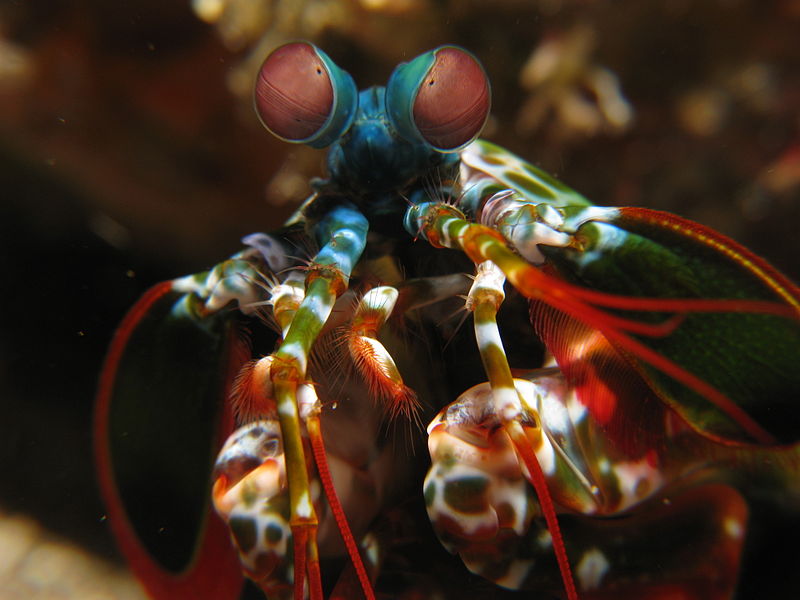Mantis Shrimp Facts
- Perhaps most amazingly, the term Mantis Shrimp actually refers to any of the species in the suborder of Unipeltata. This contains a total of 451 separate species. All of these, however, evolved as highly aggressive species of marine crustaceans.
- The various members of this remarkable suborder all belong to one of two classifications. Uniquely, these classifications remain based on the manner in which the species attacks. Each species, therefore, gets classified as either a spearer or smasher.
- Quite surprisingly, perhaps, the animal often ranks as one of the most important predators in its given region. This holds true despite its relatively small size. Yet despite this, the amazing creature still remains comparatively poorly understood.
- For the moment, all species classified under the name of Mantis Shrimp appear to have stable populations. Fortunately, this trend appears to exist throughout the entirety of their natural ranges. This makes them more fortunate than some, though.
- Due to these facts, the IUCN currently has no listing for any of them on its Red List of Threatened Species. That could potentially change, since the creatures face increasing threats. The greatest of these, though, is the result of the effects of climate change.
Related Articles
Mantis Shrimp Physical Description
Quite understandably, given the large number of types of Mantis Shrimp, physical differences exist. Certain natural traits remain consistent among all recognized species in the fabulous suborder, however. That’s the very basis of the common grouping, in fact.
Since Nature loves variety, the various species display a comparatively wide variety of colors. These hues further range from a drab brown to bright, almost neon-like colors. The great majority of the different species, however, display the highly colorful patterns.
Sizes also naturally vary among the different forms of the fascinating Mantis Shrimp. Most of the forms also display various degrees of sexual dimorphism. In the case of these arthropods, this manifests itself in terms of males being larger than the females.
An overall average size, though, equals around 12 in (30 cm) in body length. Exceptional specimens do occasionally appear, however. A few of these attain measured lengths of as much as 15 in (38 cm). Only males have the highly oversized pair of claws, though.
- Kingdom: Animalia
- Phylum: Arthropoda
- Class: Malacostraca
- Order: Stomatopoda
Mantis Shrimp Distribution, Habitat, and Ecology
Perhaps most notably, the types of the Mantis Shrimp have an impressive distribution. That’s because they inhabit nearly all temperate and tropical waters. The greatest concentration of both species and numbers appear between Hawaii and eastern Africa.
The two different classifications of Mantis Shrimp, distinctly, also prefer different types of habitat. The spearers prefer areas of soft sediment. The smashers, meanwhile, typically prefer either hard ground or regions of coral. Yet, both varieties create burrows.
Varying species of Mantis Shrimp also evolved different patterns of behavior. In point of fact, the arthropods live as either nocturnal, diurnal, or crepuscular. Unlike most crustaceans, it will hunt and pursue prey, if none comes within reach of its hiding place.
Though fewer in number, the smashers without doubt remain the most physically impressive group. This characteristic owes its existence to a particular ability, however. In proportion to their body size, they possess the fastest strike of any known creature on earth.
To put this in a clearer perspective, the effect is equivalent to arming the animals with miniature handguns. That’s due to the fact that these amazing shrimp remain capable of striking with a force and velocity roughly equal to that of delivered by a 22 caliber bullet.
The unfortunate prey, in fact, is actually struck twice with a single strike. The first remains the physical impact, itself a deadly strike. Secondly, however, comes the shock wave resulting from the velocity of the strike. The combined effect becomes devastating.
Species Sharing Its Range
Check out our other articles on 7 Magnificent Wild Canines, Oilbird, Melissani Cave, Plumed midge-orchid, Eastern Diamondback Rattlesnake, Indian Bullfrog, Crane Fly, Maned Wolf

